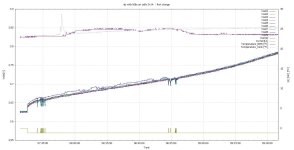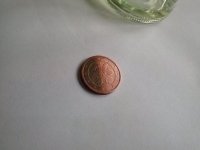x-speed said:
There is average 18mOhm, and rather huge variance and randomness after small lateral shifts. Thats well beyond my threshold of acceptability.
With the full program of contact surface treatment the unacceptable high and highly variant R_contact at the positive terminals came down to about 4mOhm at first, and rather reliable. Without using more magnet power.
This 4p10s pack from a factory had partial and incompletely welded contacts. I welded the rest, but on one of the undone links I applied the NIB program, thus 4 positive terminal and 4 negative terminal magnetic contacts using 0.15mm nickel strips and serial soldering:
View attachment 2
Thus I can directly compare the NIB contact situation with the normal welded contacts. (The link geometry is rather forced by the special battery construction and the spacers here.)
8mm x 1mm standard N38 NIBs. So I could try 1, 2 or 3 of them stacked per contact. I'm finally using 2, thus 8mm x 2mm effecticly . 3 would add some 25% more pressure (it doesn't increase linearly/50%) - thus some 20% less R_contact - but then the situation would be not flat enough for my taste.
Using a OZ890 BMS I can log the cell voltages rather precisely with 1.22mV resolution (over I2C + Bluetooth on a Android phone or PC or µC-Logger). This enables watching for bigger jumps of the R_contact of the NIB contacts, and the temperature nearby - live during usage.
This graph for example shows the very first slow 1A charge of the freshly linked pack, where the contacts were still uncleaned (!) :


(There are some current interruptions so that one can see the absolute voltage sags/resistances of the cells.)
During the charge at the beginning I made forced mini-movements on the NIB contacts . The positive NIB contacts are on cell(array) #3, thus you see the rather huge variance pattern of the blue "Vcell3" curve - some 10mV variance - while the other cell voltages remain equal within a 5mV band. This means some 10mV/0.25A = 40mOhm per positive terminal contact - uncleaned! The constant situation after 8:45 which seems better (R_contact ~ 10mOhm constant) is yet a rather random optimum found "trial and error" by lateral shifts (watching with voltmeter on each contact), thus the situation is unreliably random without the extended treatment.
After the full contact surface treatment and oxygen stop with Vaseline now there is no more noticeable voltage variance pattern on cells #3. Only a little higher constant resistance. And important: its rather reliable - not a fragile random optimum.
Meanwhile I made 3 bike tours with that pack, using this pack in parallel with another pack to have some 800Wh. One was a day tour with 130km and all kinds of paths, consuming some 80% of total battery capacity. Its well stable according to the measurements. Measuring the contacts individually and precisely after use (avoiding shifts while unpacking), I found repeatedly that the contacts had even a little lower resistance - with exception of 2 negative terminal contacts which I did not threat extended: here resistance increased a little (and may get a lot worse over time).
On the positive terminals I got ~2.6mOhm average after that "self-improvement". And 1.0mOhm on the 2 extra treated negative terminals. So it seems that micro-movements and/or peak currents support in working the contact materials even better together - without converse effects when fully cleaned/deox'ed and when oxygen is kept away.
So after all it feels well ok for long term observations ...
Mechancial stability: I did not feel any potential trouble regarding the mechanics of the NIB contacts - though I did not position things overly exact - it all feels rather tolerant. The thin ferromagnetic nickel strips are held tough in place by the magnets - mag force quite undamped - the soldered nickel strip assembly makes things rather cohesive as a whole - could hardly be forced across the plastic barriers. The were no noticeable movements of the magnets observed when carefully unpacking things after use. The magnets are not extra fixed with glue or anything so far - perhaps I may do some tiny little drop super glue fixing when nothing changes anymore after some time, but think its not really necessary. As soon as there is soft cover material thick enough on the whole contact stuff, things are quite cohesive. >2cm wrapping stuff keeps iron things well away - there is no problem regarding with NIB pressure/position being influenced even with 3mm distance to iron tools. Yet I'll check the effects on a almost terminated bank card...
Temporarily for now while testing I'm packing/rolling the battery simply with soft packaging material tightly, 2cm or so, then hard carton, and that into a camera bag with shoulder straps, and that into the bottom of a pannier on the touring bike - luggage on top. The principle will be the same on the final package I think: cell pack - (power tape around sides) - soft stuff - tape - hard stuff - (soft bag). I don't need power tape around the cell sides here, because the cell holder is one complete rather stable piece.
Summary so far: The R_contact particularly on the positive terminals is most critical. Its not a no-brainer. Correct contact treatment and resistance checks are needed.
(@radad, I wonder if you have some measure for the situation on the positive terminals?)
After the full treatment R_contact on the positive terminals is still not completely satisfactory, but below my 5mOhm threshold (cell Rdc ~40mOhm). Without the extended surface treatment program and Vaseline, it would be rather critical and unreliable. Using more expensive N50 NIBs instead of N38 on the positive terminals could perhaps provide some factor. The 8mm NIBs cover the positive terminals rather well already, the negative terminals are significantly less critical. Perhaps 9mm or even 10mm NIBs would turn out into little more force/less resistance, but from then there is less effective overlap on the small positive area - and measurements become difficult. I don't want more than 2mm height. So perhaps N50 9mm x 2mm would be quite perfect on the positive terminals - somewhat more expensive for complete packs. But its acceptable as it is. (Usually cell Ri increases during cell aging and the effect will be higher than R_contact as of now within months I guess.)
Possible more expensive improvements which do not add geometry: silvering of contact surfaces, superconductive nanomaterial (?) ...





